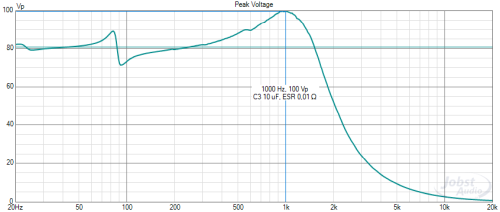Calculate Capacitor Voltages
 Capacitors are often only supplied with the rated voltage
Capacitors are often only supplied with the rated voltagespecified as direct current (DC).
However, on a crossover we need alternating current (AC) for proper dimensioning.
| Calculate Current (Insert AC or DC) | ||||
| DC | Volt | AC | Volt | |
| Last | Ohm | Veff | Volt | |
| Calculate values for ELKO | ||||
| For speaker load capacity | ||||
| HiFi: | W | Veff: | W | |
| PA: | W | AC: | W | |
| Peak: | W | |||
| Capacitor parallel connection | |||||
| C1 | + | C2 | = | Cges | |
| µF | + | µF | = | µF | |
| Capacitor series connection | |||||
| C1 | + | C2 | = | Cges | |
| µF | + | µF | = | µF | |
Explanation:
This calculator assumes typical VDC to VAC values.
Depending on the capacitor type, VAC can, in rare cases,
also be 3-6dB lower than the values calculated here.
AC and DC values should always be taken from the data sheet.
| DC / Vpeak | DC voltage or Vpeak for AC voltage |
| ELKO | Insert VAC to Veff (Ignore AC) |
| Veff | RMS-Voltage (3dB) - Minimum without headroom |
| AC | RMS-Voltage +1dB - Typical specification |
| HiFi | RMS-Voltage +3dB - Suitable for typical HiFi-Speakers |
| PA | RMS-Voltage +6dB - Suitable for typical PA-Speakers |
| Peak | RMS-Voltage +9dB - Oversized |
This calculator assumes typical VDC to VAC values.
Depending on the capacitor type, VAC can, in rare cases,
also be 3-6dB lower than the values calculated here.
AC and DC values should always be taken from the data sheet.


